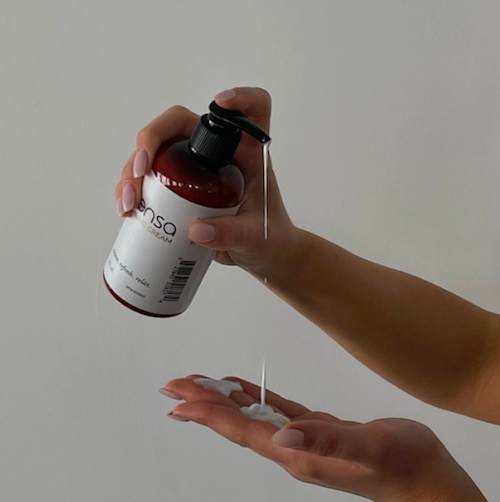Your Guide To Types of Acne & The Best Treatment Options
Your Guide To Types of Acne & The Best Treatment Options
Nothing is more frustrating than waking up to a new pimple or inflamed skin. Around 85% of people suffer from acne in their lifetime. So, know you’re not alone if one of your greatest desires is to have a calm, clear complexion. Acne, a condition caused by clogged pores from dirt, oil or dead skin cells, is one of the most common skin issues among teenagers and adults (into your 30s, 40s, or sometimes, even your 50s). Aside from plugged pores, other common causes of acne include stress, bacteria, hormone fluctuations, diet, general inflammation, genetics and certain medications. While everyone wants a quick fix, different types of acne have different root causes. First, you need to identify the type(s) of acne you have to discover the right treatment and smoothen your skin.
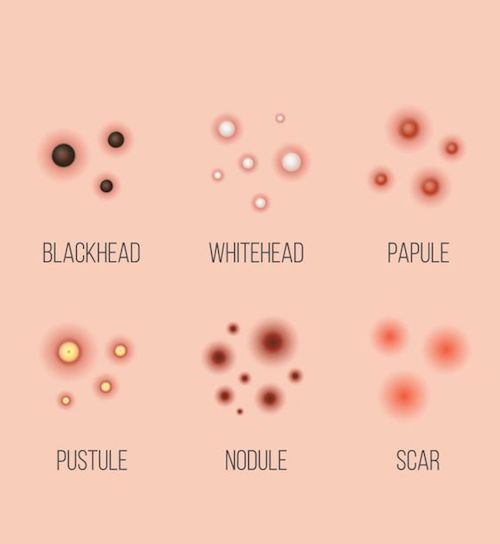
Credit: Stylecaster/Pinterest
Natural or at-home remedies and OTC treatments should considerably reduce mild to moderate breakouts. However, moderate to severe acne might require a prescription medication from your doctor or dermatologist.
Here’s everything you need to know about the different types of acne, common causes, the best treatment options and how to get rid of acne scars.
Noninflammatory vs. Inflammatory Acne
Before diving into the different acne types, it’s important to understand the difference between noninflammatory and inflammatory acne. Noninflammatory acne is the surface-level type of acne, marked by clogged or closed pores without any swelling. Comedones (whiteheads and blackheads) are considered a type of noninflammatory acne. Inflammatory acne arises from deeply-clogged pores filled with dead skin cells, oil, pus, dirt or bacteria, which triggers an inflammatory response and causes swelling, soreness and redness. Pustules, nodules and cysts are common types of inflammatory acne.
Noninflammatory acne is considered the more “mild” class of acne and is treated using topical treatments (OTC or prescription), natural remedies and changes in your diet or skincare routine. Inflammatory acne is the more high-maintenance of the two acne groups. Treatments for inflammatory acne include topical treatments or antibiotics and oral medications like Isotretinoin (a vitamin A derivative), hormonal supplements (like birth control pills) and antibiotics, among others.
Types of Acne:
Whiteheads
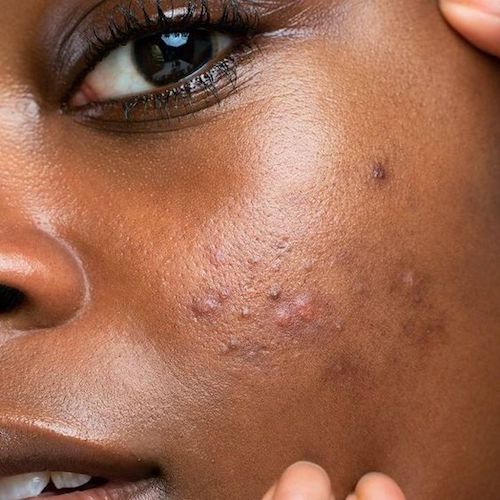
Credit: Target/Pinterest
Whiteheads are small white or yellow bumps that form on the skin’s surface due to clogged pores filled with excess sebum (oil) and dead skin cells. They are a form of closed comedonal acne. They often form on the face, back, chest, neck and upper arms. However, whiteheads can form from all your oil glands and can appear anywhere on the body. Whiteheads are often caused by hormonal changes and are most common among teenagers. Around 10-20% of adults still struggle with whiteheads through their 20s, 30s and beyond. Increased keratin production and bacteria on the skin can also cause whiteheads.
Whiteheads often are treated with OTC acne products. Some of the most effective ingredients for treating whiteheads include salicylic acid, benzoyl peroxide and retinoids (a vitamin A derivative). Natural remedies such as tea tree oil (anti-inflammatory), aloe vera (anti-bacterial) and witch hazel (opens pores) have shown to be effective in reducing the appearance of whiteheads. Other treatment options for whiteheads include gentle exfoliation (unplugs pores), microdermabrasion and chemical peels.
Blackheads

Credit: @maloriedaronche/Twitter
Blackheads are open, small bumps on the skin clogged with excess sebum (oil) and dead skin cells. They are a form of comedonal acne. These closed comedones occur when the pores (or hair follicles) get inflamed. However, unlike whiteheads, these plugged pores get exposed to the air, which gives them their dark appearance. Blackheads are not pimples (like whiteheads are), so they should not cause any discomfort and won’t be felt when they appear on the skin. Common causes of blackheads include excess sebum (oil) or keratin production, hormonal changes (especially on birth control pills or during your menstrual cycle) and an increase of bacteria on the skin.
Treatment options for blackheads are very similar to those for whiteheads. OTC products with salicylic acid, benzoyl peroxide and retinoids are known to be effective in treating blackheads. If you’re seeking a DIY solution, combine baking soda and water to create a natural exfoliator. Some other best natural remedies for blackheads include tea tree oil, clay masks or homemade lemon, brown sugar and honey scrub.
Papules
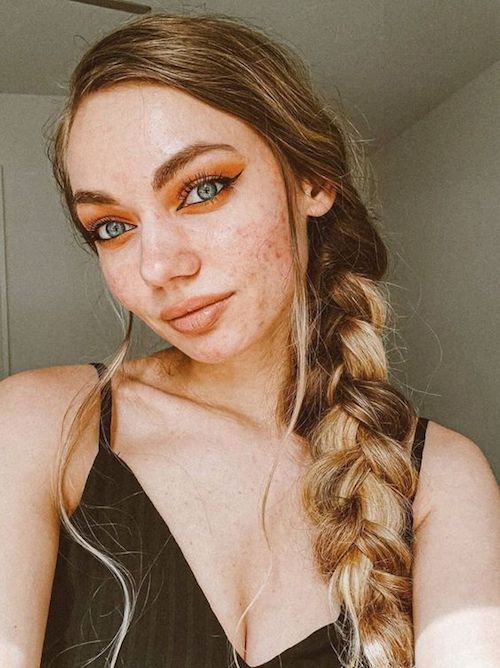
Credit: Fashionuer/Pinterest
Papules are a type of inflammatory acne that presents as solid, inflamed bumps caused by clogged pores, hormonal changes or certain medications. They form when excess oil or dead skin cells clog up your pores, and the bump ruptures deep into the skin tissue instead of on its surface. Unlike other forms of acne, papules don’t contain any pus. Common causes of papules include excess sebum production or bacteria on the skin, increased androgen (sex hormones) production, stress, poor diet and some medications.
For mild to moderate cases, it is recommended first to try using salicylic acid or benzoyl peroxide to manage breakouts. If these OTC acne treatments aren’t strong enough, your doctor might prescribe a product like retinoids or a topical antibiotic to treat papules. Oral treatment options for more severe acne include antibiotics (such as azithromycin or erythromycin, doxycycline or minocycline) and hormonal therapies like birth control or anti-androgen pills.
Pustules

Credit: WhoWhatWear/Pinterest
Pustules are a type of acne where clogged pores cause the skin to bulge. These small red pimples are filled with pus that builds up under the skin. This class of acne signals an infection in the pore cavity, which causes inflammation and gives them a white or yellowish appearance. They look similar to regular pimples but can grow fairly large in size (large pustules turn into cysts – scroll down to learn more about this type of acne later). Pustules are easy to spot because they will be red, inflamed and sore to the touch. Common causes of pustules include hormonal acne (through puberty), hormone imbalances (for adults) or bacterial infection, chronic skin conditions (such as rosacea and psoriasis) or an allergic reaction.
For acne-related pustules, use OTC spot treatments containing salicylic acid or benzoyl peroxide twice a day after washing your face. If these milder treatments don’t calm your breakouts, consider going to your doctor or dermatologist for a prescription-strength salicylic acid, antibiotic, steroid cream or similarly effective topical products.
Use Zensa Healing Cream as a natural remedy to reduce inflammatory acne symptoms (or other chronic skin conditions). It contains medical-grade calendula oil and grapefruit essential oil, both known for their anti-bacterial, anti-fungal and collagen-stimulating benefits. Calendula oil is perfect for sensitive, acne-prone skin and is known for soothing and skin-firming properties. Grapefruit essential oil is a natural astringent, which helps tighten pores and controls oil production to manage and protect against future breakouts.
Credit: @zensaskin/Instagram
Calendula oil and grapefruit essential oil both provide anti-inflammatory benefits, thanks to their high antioxidant content. These properties make them an effective natural remedy for eczema, rosacea and psoriasis. Zensa Healing Cream combines these two medicinal ingredients with aloe vera, cucumber extract and shea butter to promote wound healing, reduce itching and soothe bumpy, red or cracked skin.
Nodules
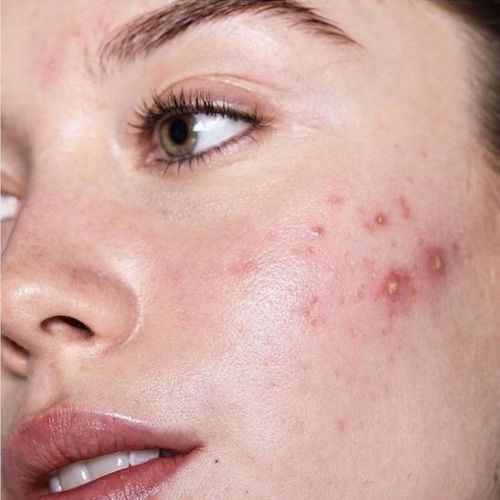
Credit: Glow Cosmetics UK/Pinterest
Nodular acne is a severe type of inflammatory acne that presents as raised hard, red (or skin-toned) lumps or knots under the skin. These pimples have no head, are deep under the skin and are often very painful. Nodular acne forms when dead skin cells, hair or oil (sebum) clog your pores and the bacteria that naturally live on the surface get trapped inside your skin. Causes of nodular acne include hormonal changes, fluctuations or imbalances, genetics, excessive sweating, stress and certain medications (like corticosteroids). For females, nodules tend to appear on their jawline or chin and on the face, back or chest for males.
Nodular acne cannot be treated with any OTC topical medication. Your doctor or dermatologist will see whether a topical, prescription-grade treatment, like salicylic acid, benzoyl peroxide, or retinoids, or oral medication, such as isotretinoin (Accutane), birth control pills (for females) or tetracycline (an antibiotic) could work best for you. If you have a particularly large nodule, you might need cortisone injections (done with a fine needle and steroid medication) to reduce inflammation and speed up the healing process.
It’s important to treat nodular acne quickly and never pick or pop the acne lesion, which can lead to scarring.
Cysts
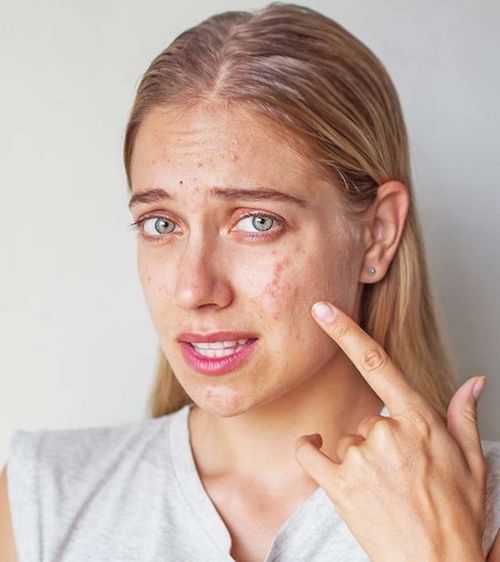
Credit: Stylecraze/Pinterest
Cystic acne is a type of inflammatory acne that forms pus-filled, painful pimples deep under the skin. These lesions form when oil and dead skin cells clog your pores. Bacteria also gets trapped underneath the skin, which triggers swelling and inflammation. Unlike nodules, cystic acne contains pus and appears as a red lump underneath the skin with a white or yellowish head. These bumps are often painful to the touch and can ooze or have a crusty outer layer. The pimples can vary from a small spot to a dime-sized blemish. Cystic acne is considered the most severe type of acne.
Common causes of cystic acne include puberty (cystic acne is common among teenagers), other hormonal changes (a woman’s cycle, menopause, stress) and genetics. Never pick or pop any acne cysts. Manipulating these lesions can easily result in acne scarring or an infection. Go to your provider immediately to seek the proper medication for your complexion. Cystic acne typically takes around 3 months to clear up after starting treatment.
Treatment for cystic acne usually combines taking oral antibiotics and applying a prescription-strength topical medication. Common topical treatments for cystic acne include benzoyl peroxide (to reduce bacteria on the skin), salicylic acid or azelaic acid (to get off dead skin cells and kill bacteria) and retinoids. Some popular oral medications for cystic acne are Isotretinoin and birth control pills. Corticosteroid injections, incisions and draining are other methods that can be used for treating cystic acne.
Acne Scars: Causes & Treatment
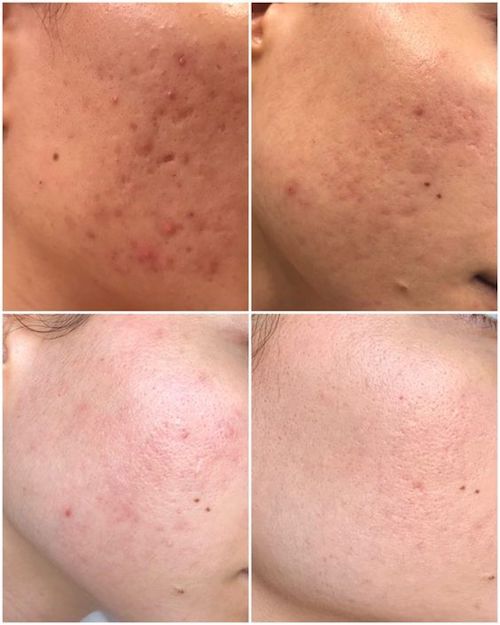
Credit: Poosh/Pinterest
Acne scars form as a result of the inflammation from acne lesions. Excess oil, dirt, bacteria and dead skin cells clog pores and cause them to swell, which breaks a follicle wall and triggers the body’s inflammatory response. During this healing process, collagen production increases to form a fresh layer of skin. While the dermis repairs itself, the new skin layer does not look as smooth as before the breakout. Atrophic (or depressed) scars develop from a lack of tissue being replaced below the surface during the recovery process, leaving a small indent on the top layer of your skin. If the body produces too much collagen while healing, it creates a raised bump called a hypertrophic (or keloid) scar.
Acne scars can be a byproduct of any type of inflammatory acne (papules, pustules, nodules and cysts). More inflamed blemishes and deeper breakouts are more likely to cause scarring.
Retinoids and microneedling are effective treatment options for atrophic (depressed) acne scars. A 2015 study found that acne scars showed ‘good to very good’ improvement after 3 months of microneedling. If you’re considering this cosmetic treatment, read our guide on what to expect before and after microneedling. Corticosteroid injections are a proven treatment for raised scars. When seeking the best skincare for acne scars, look for ingredients like lactic acid (or diluted apple cider vinegar), salicylic acid, vitamin C and alpha hydroxy acids (AHAs).

However, it is also possible to mistake post-inflammatory hyperpigmentation with acne scarring. This hyperpigmentation is temporary and will fade over time.
Whether you’re treating acne scars or breakout-related hyperpigmentation, Zensa Healing Cream helps increase cellular turnover and collagen production to speed up the healing process. Its medicinal ingredients reduce inflammation and nourish the skin to repair the skin barrier and minimize scarring as your breakouts heal. Apply to the skin twice daily after cleansing for best results. Always speak with your doctor or dermatologist before adding a new skincare product to your acne treatment regimen.

